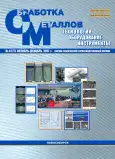Intercerical Quenching of Low-Carbon Steel with the Formation of a Disperse Multiphase Structure
- Authors: Panov D.O1, Barsukova T.Y1, Smirnov A.I2, Orlova E.N1, Simonov Y.N1
-
Affiliations:
- Perm National Research Polytechnic University
- Novosibirsk State Technical University
- Issue: No 4 (2017)
- Pages: 6-18
- Section: MATERIAL SCIENCE
- URL: https://bakhtiniada.ru/1994-6309/article/view/302112
- DOI: https://doi.org/10.17212/1994-6309-2017-4-6-18
- ID: 302112
Cite item
Full Text
Abstract
About the authors
D. O Panov
Perm National Research Polytechnic University
Email: panovdmitriy85@gmail.com
29, Komsomolsky prospekt, Perm, 614990, Russian Federation
T. Y Barsukova
Perm National Research Polytechnic University
Email: tanok4444@yandex.ru
29, Komsomolsky prospekt, Perm, 614990, Russian Federation
A. I Smirnov
Novosibirsk State Technical University
Email: micros20t@mail.ru
20, Prospekt K. Marksa, Novosibirsk, 630073, Russian Federation
E. N Orlova
Perm National Research Polytechnic University
Email: 77zhenya77@mail.ru
29, Komsomolsky prospekt, Perm, 614990, Russian Federation
Y. N Simonov
Perm National Research Polytechnic University
Email: simonov@pstu.ru
29, Komsomolsky prospekt, Perm, 614990, Russian Federation
References
- Садовский В.Д. Структурная наследственность в стали. - М.: Металлургия, 1973. - 205 с.
- Липчин Н.Н., Коковякина С.А. Структурный механизм превращений при нагреве стали // Металловедение и термическая обработка металлов. - 1970. - № 9. - С. 2-7.
- Счастливцев В.М., Копцева Н.В. Электронно-микроскопические исследования аустенита при нагреве конструкционной стали // Физика металлов и металловедение. - 1976. - Т. 42, № 4. - С. 837-847.
- Zel'dovich V.I. Three mechanisms of formation of austenite and inheritance of structure in iron alloys // Metal Science and Heat Treatment. - 2008. - Vol. 50, вып. 9-10. - P. 442-448. - doi: 10.1007/s11041-009-9082-3.
- Лазерный нагрев и структура стали: атлас микроструктур / В.Д. Садовский, В.М. Счастливцев, Т.И. Табатчикова, И.Л. Яковлева. - Свердловск: Уральский рабочий, 1989. - 102 с.
- Бернштейн Л.М., Капуткина Л.М., Прокошкин С.Д. Отпуск стали. - М.: МИСИС, 1997. - 336 с.
- Голованенко С.А., Фонштейн Н.М. Двухфазные низколегированные стали. - М.: Металлургия, 1986. - 207 с.
- Физические основы электротермического упрочнения стали / В.Н. Гриднев, Ю.Я. Мешков, С.П. Ошкарев, В.И. Труфилов. - Киев: Наукова думка, 1973. - 335 с.
- Критические точки при быстром нагреве деформированной стали / В.Н. Гриднев, О.М. Ивасишин, Ю.Я. Мешков, С.П. Ошкадеров // Металлофизика. - 1975. - Вып. 61. - С. 98-100.
- Дьяченко С.С. Образование аустенита в железоуглеродистых сплавах. - М.: Металлургия, 1982. - 128 с.
- Горностырев Ю.Н. Микроскопические механизмы гетерогенного зарождения новой фазы при полиморфном ГЦК-ОЦК-превращении // Фазовые и структурные превращения в сталях: сборник научных трудов. - Магнитогорск: Изд-во Магнитогор. дома печати, 2008. - С. 31-57.
- Structure formation in low-alloy pipe steel during heating in the intercritical temperature range / A.N. Makovetskii, T.I. Tabatchikova, I.L. Yakovleva, N.A. Tereshchenko, D.A. Mirzaev // The Physics of Metals and Metallography. - 2012. - Vol. 113, iss. 7. - P. 704-715. - doi: 10.1134/S0031918X12070083.
- Formation of the structure and properties of a low-carbon martensitic steel 12KH2G2NMFT upon quenching / S.S. Yugai, L.M. Kleiner, A.A. Shatsov, N.N. Mitrokhovich // The Physics of Metals and Metallography. - 2004. - Vol. 97, N 1. - P. 98-103.
- Huang J., Poole W.J., Militzer M. Austenite formation during intercritical annealing / // Мetallurgical and Materials Transactions A. - 2004. - Vol. 35, iss. 11. - Р. 3363-3375. - doi: 10.1007/s11661-004-0173-x.
- In-situ determination of austenite and martensite formation in 13Cr6Ni2Mo supermartensitic stainless steel / A. Bojack, L. Zhao, P.F. Morris, J. Sietsma // Materials Characterization. - 2012. - Vol. 71. - P. 77-86. - doi: 10.1016/j.matchar.2012.06.004.
- Chang M., Yu H. Kinetics of bainite-to-austenite transformation during continuous reheating in low carbon microalloyed steel // International Journal of Minerals, Metallurgy and Materials. - 2013. - Vol. 20, iss. 5. - P. - 427-432. - doi: 10.1007/s12613-013-0746-z.
- Growth of austenite from as-quenched martensite during intercritical annealing in an Fe-0.1C-3Mn-1.5Si alloy / R. Wei, M. Enomoto, R. Hadian, H.S. Zurob, G.R. Purdy // Acta Materialia. - 2013. - Vol. 61, iss. 2. - Р. 697-707. - doi: 10.1016/j.actamat.2012.10.019.
- Effect of heating rate on ferrite recrystallization and austenite formation of cold-roll dual phase steel / P. Li, J. Li, Q. Meng, W. Hu, D. Xu // Journal of Alloys and Compounds. - 2013. - Vol. 578. - P. 320-327. - doi: 10.1016/j.jallcom.2013.05.226.
- Effect of initial microstructure on austenite formation kinetics in high-strength experimental microalloyed steels / E. López-Martínez, O. Vázquez-Gómez, H.J. Vergara-Hernández, B. Campillo // International Journal of Minerals, Metallurgy and Materials. - 2015. - Vol. 22, iss. 12. - P. 1304-1311. - doi: 10.1007/s12613-015-1198-4.
- Патент 2532628 Российская Федерация, МПК C 22 C 38/38. Сталь для изготовления изделий с повышенной прокаливаемостью / Ю.Н. Симонов, М.Ю. Симонов, Г.С. Шайманов, Д.П. Подузов. - № 2013113589/02; заявл. 26.03.2013; опубл. 10.11.2014, Бюл. № 31.
- Recrystallization and formation of austenite in deformed lath martensitic structure of low carbon steels / M. Tokizane, N. Matsumura, K. Tsuzaki, T. Maki, I. Tamura // Metallurgical Transactions A. - 1982. - Vol. 13, iss. 8. - Р. 1379-1388. - doi: 10.1007/BF02642875.
- Stages of austenitization of cold-worked low-carbon steel in intercritical temperature range / D.O. Panov, Y.N. Simonov, L.V. Spivak, A.I. Smirnov // The Physics of Metals and Metallography. - 2015. - Vol. 116, N 8. - P. 802-809. - doi: 10.1134/S0031918X15080128.
- Патент 2561315 Российская Федерация, МПК G 01 N 25/02. Способ определения температур фазовых превращений в металлических материалах / Ю.Н. Симонов, Д.О. Панов. - № 2014120830/28; заявл. 22.05.2014; опубл. 27.08.2015, Бюл. № 24.
Supplementary files






